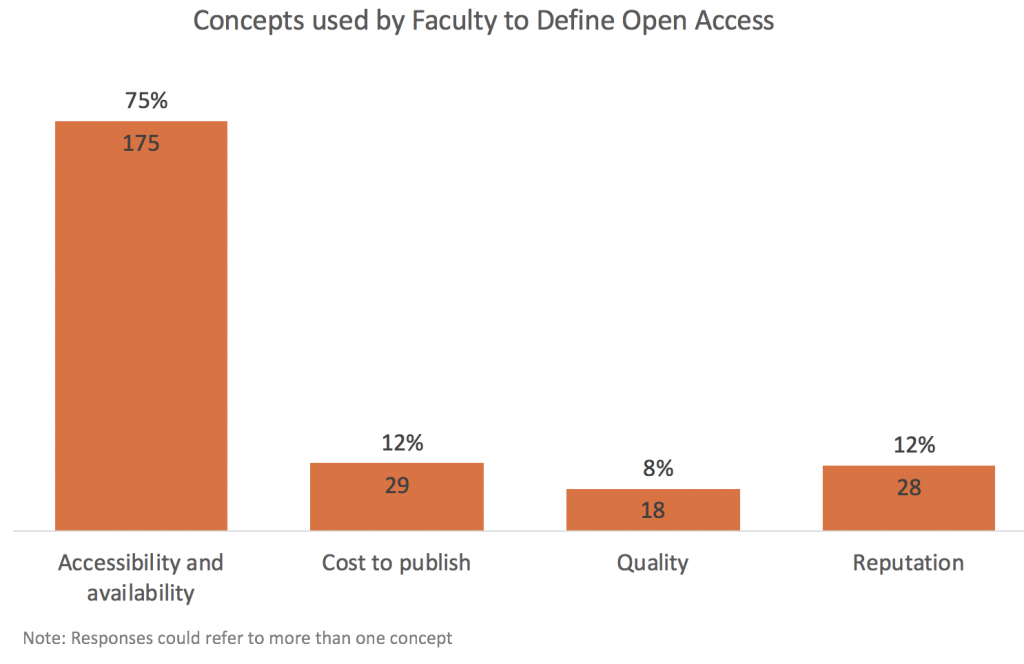Academic review promotion and tenure documents promote a view of open access that is at odds with the wider academic community

By Juan Pablo Alperin, Esteban Morales and Erin McKiernan. First published on the LSE Impact Blog on July 17, 2019.
The language of Open Access (OA) is littered with so many colours, metals, and precious stones, that you would be forgiven for losing track. The proliferation of these “flavours” of OA has been a useful analytical tool for those that study scholarly communication, but it has also complicated the discussion about what academics can do to realise the “unprecedented public good” of opening access to research that was at the heart of the Budapest Open Access Initiative.
Whilst those steeped in discussions about OA might be concerned about new economic models and the lack of clear licensing of much OA content (“bronze OA”), how do faculty from across the disciplines actually define OA? Do these definitions even matter to those outside of scholarly communication circles? Evidence we have gathered as part of a project to study incentives in academia suggests they do.
In a recent study, analysing documents related to the review, promotion, and tenure (RPT) process at a representative set of 129 universities from the United States and Canada, only 5% of institutions mentioned Open Access. Just as fascinating as this lack of interest and support for making research OA, however, were the misconceptions we found surrounding the term itself. For example one document cautioned faculty against “publishing in journals that are widely considered to be predatory open access journals”. Others equated OA with materials that are “self-published, inadequately refereed, open-access writing.”
Given that the documents that govern the RPT process embed these misconceptions and false associations, we wanted to know how faculty themselves thought about OA. Do faculty commonly associate OA with low-quality, non-refereed, predatory content?
To answer this question, we surveyed faculty at 60 of the institutions from our sample about their perceptions of the RPT process, including an open-ended question asking them to define, in their own words, the term “Open Access.” We received 234 responses to this question, which we analyzed using open-coding and constant comparison. Our results show that faculty tend to define OA along four key axes: (1) Accessibility and Availability, (2) Cost to Publish, (3) Quality, and (4) Reputation. A distribution of how many responses fell in each category can be seen below.
Accessibility and Availability
The frequencies of the responses were encouraging: 70% of faculty defined OA by the ease with which a journal and its articles can be accessed by readers, including how much they have to pay (i.e., free). They define OA with phrases like “…accessible to all, free, on-line”, “do not need to pay to access journal articles” and, our personal favourite, “Can post link to Facebook, my mom can read it.”
Cost to Publish
At the same time, 12% of the respondents equated OA with an “author-pays” model. In defining OA, faculty responded by saying that OA is “Expensive for academics” or that OA means that one “Must pay to publish.” This conflation is not uncommon, both among academics and in the popular press. Although the author-pays model has been successful at growing OA, and has become the focus of some efforts to “flip” journals to OA (like OA2020 and Plan S), the majority of OA journals registered in the DOAJ do not follow this model, and increasingly groups are standing up against it.
Quality and Reputation
Other definitions expressed concerns about the quality and reputation of OA publications, which featured in 7% and 11% of definitions, respectively. Respondents defined OA with phrases like “often not the highest-quality” and “not always respected.” Such concerns about quality have surfaced in previous faculty surveys, and often stem from a misconception that OA journals have less rigorous peer review processes, despite evidence to the contrary and the transparent peer review in place at many OA journals.
Conclusions
Overall, the results of our survey give reason to be optimistic: the majority of faculty understand that OA is about making research accessible and available. However, they also point to persistent misconceptions about OA, like necessarily high costs and low quality. This raises questions: How might these misconceptions be affecting RPT evaluations? How should researchers who want to prioritise the public availability of their work guard against the potential that their peers hold one of these negative associations? And, as a community, how can we better communicate the complexities of OA without further diluting the central message of open access? Perhaps we can begin by adequately representing and incentivising the basic principles of openness in our RPT documents.
The findings and views presented here are the collective effort of the whole Review, Promotion and Tenure team at the Scholarly Communications Lab, including the authors of this blog post listed above, Dr. Lesley Schimanski (Simon Fraser University), Dr. Meredith Niles (University of Vermont), and Ms. Michelle La (Simon Fraser University).

